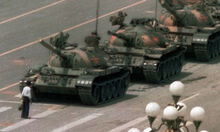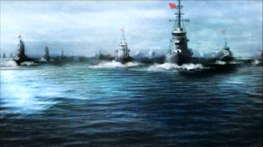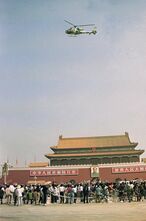| ||||||||||||
| Anthem | "March of the Volunteers" | |||||||||||
| Capital (and largest city) |
Beijing | |||||||||||
| Other cities | Shanghai, Ningbo, Xiamen, Shenyang, Guanzhao, Fuijan, Dandong, Urumqi, Lhasa | |||||||||||
| Language official |
Mandarin Chinese | |||||||||||
| others | Cantonese, Fukien, Mongolian, Xibe, Russian | |||||||||||
| Religion main |
State atheism | |||||||||||
| others | Buddhism, Taoism, Christianity, Islam | |||||||||||
| Ethnic Groups main |
Han Chinese | |||||||||||
| others | Manchu, Ugyhur, Tibetan, Russian, Mongolian, Korean | |||||||||||
| Government | Single-party communist state | |||||||||||
The People's Republic of China (PRC) was a sovereign state in East Asia ruling mainland China from 1949-1991. During its governance, it was one of the most populous states in the world, reaching over 1 billion people during the 1980s. While it was originally neutral during the beginning stages of the Third World War, it eventually joined the war as an ally of the Soviet Union. However, this proved to be the downfall of the People's Republic as its failures during the war caused citizens and elements of the PLA to rebel against the Chinese Communist Party, causing a Second Chinese Civil War. Following the victory of the rebels over the communist, the PRC fragmented into the Chinese Federated Union, Tibet, and East Turkistan.
History
The PRC was established in the mainland on October 1, 1949 by Chairman Mao Zedong, following the Communists' victory over the Nationalist during the First Chinese Civil War. During the Korean War, Red China intervened on October 1950 on the side of the North Koreans, in which they managed to push the United Nations forces back to the 38th parallel. China's entry into the Korean War would then make the war into a "tug-of-war" progress, with both sides gaining and loosing territories until July 27, 1953. In 1956, Mao would initiate the "Great Leap Forward" which ended in disaster. During the 1960s, Mao would then launch the Cultural Revolution in purging the Communist Party of counter-revolutionary ideas. Majority of the Chinese youth were indoctrinated with Mao's red book and were known to have killed millions of people during the purges. In 1969, the Sino-Soviet alliance finally splintered and the two nations fought a border clash along their respective borders. In 1971, China and the United States began a series of rapprochement on the common interest of containing the Soviet Union. In addition to that, China replaced Taiwan in the United Nations Security Council. This culminated in a visit by Richard Nixon to China in 1972 and in 1979, the United States would officially recognized the PRC as the governing body of China.
Both China and the U.S. would find a common enemy with the Soviet Union. When the USSR invaded Afghanistan in December 1979, China and the U.S. supported the anti-Soviet mujahideen with arms, training, and funds - usually by way of Pakistan. The PLA also garrisoned en masse its troops along the Sino-Afghan border in Xinjiang to deter the Soviets.
Tiananmen Square Protests of 1989
On April 15, 1989, Chinese university students gathered around Tianenmen Square in Beijing to after the death of reformer Hu Yaobang. Hu was a liberal reformer of the communist party who was desposed by hardliners after loosing a political struggle on where to lead China's economic and political growth. Over the weeks that followed, these students would increase in numbers; not only students did join in but other commoners such as hotel workers, labor workers, taxi drivers, and even farmers from far away places. A month into the protests, martial law was declared on May 20 by Premier Li Peng. However, the 38th Army of the People's Liberation Army ignored the order and sided with the protestors. Former General Secretary Zhao Ziyang, fired from his post, went to site and opened a compromise with the student protestors.

The famous Tank Man photo taken on June 4, 1989.
Li Peng took de facto leadership on June 2 due to Deng Xiaoping's ailing health. He ordered a military crackdown on the student protestors if they would not clear the square. On June 4, 1989, the Chinese government initiated a crackdown on student protesters in the square. The square was effectively under the control of the Chinese military. A single student protestor standing along the way of the tanks, named "Tank Man," was captured by Western photographers covering the event. The United States and the majority of the international community condemned the crackdown. Economic embargoes were enacted upon China. The European Community banned the sales of military hardware to the PLA. This, however, would be overshadowed by the Soviet Union's invasion of West Germany, starting World War III.
The Red Dragon Enters the War

PLAN ships off-the coast of Guam. The blockade is the first blue-water navy operation the PLAN conducted in it's history.
China was initially neutral during the beginning stages of World War III as it did not want to confront the West directly. However, due to the Western sanctions emplaced on the country, it finally declared war on the United States, NATO, and their allies. Citizens were told the war was necessary for the survival of the country and winnable against the capitalists. With American and Allied efforts mainly focused in Europe and North America, the Central Military Commission of the People's Liberation Army then launched attacks on Hong Kong, Macau, Taiwan, India, South Korea, Burma, Nepal, Japan, the Philippines, Guam and the Northern Mariana Islands. They also agreed to send reinforcements to Soviet troops in Alaska and British Columbia once the Soviets finally got these areas under control.
It would then appear that victory would not be quickly achieved despite its numerical advantage. Hopes for a quick victory for the invasion of Taiwan, longly regarded as the "rebel province" and part of the PRC, was halted due to the technologically superior ROC Navy and Air Force that pounded every PLA naval vessel in the Taiwan Strait. Additionally, ships of the People's Liberation Army were sunk on a daily basis by submarines from the U.S., U.K., Australia, Japan, and the ROC itself. In Japan, the Chinese only got as far as Hokkaido (with Soviet backing) and were driven off in Okinawa. The PLA naval blockade of Guam ended in failure as the combined forces of the United States Navy and Air Force destroyed the blockade. As for its invasion of the Philippines, the PLA never reached the capital of Manila due to the determination of both American and Filipino soldiers which stopped its advances.
Downfall
Knowing of the Central Military Commission's failures, the Communist Party began purging PLA generals for their failed offensives. The CCP, despite knowing that they entered the war at the disadvantageous side, still continued to publish via the People's Daily of the "successes" of the PLA abroad. However, it would soon turn against them as the truth found its way to the Chinese citizens. Majority of the citizens, still angry at the communist party over the Tiananmen Square Massacre of June 1989 and the fact they were lied about the progress of the war, immediately took up arms against the regime.The Central Military Commission ordered the troops that just came from North America and the Pacific to quell these riots. It would be how many months later when the war weary PLA began to question the war. Already tired of fighting, majority of the PLA defected to the rebels. There were still troops loyal to the CPC. Shots from both sides erupted, as the Second Chinese Civil War began.
The MI6 and the CIA, through Special Activities Division, began sending arms to secessionists in Xinjiang and Tibet to distract the PLA. SAD and MI6 agents were also present in aiding these secessionists in combat; subsequently they were also sent to Macau, Hong Kong, and Taiwan. The unrest in Xinjiang and Tibet brought the PLA's attention there. As this happened, the US and the West announced China's defeat in North America and the Pacific in hopes of inciting more anger among the local populace.

PLA soldiers from the 38th Army defects to the pro-democracy rebels. The 38th Army was the regiment that openly sided with the protestors during the protests of May-June 1989.
The rebels troops first released former General Secretary Zhao Ziyang from house arrest. Zhao had been fired from his post during the Tiananmen Square protests for openly hearing the student's protests. The rebels subsequently elected Zhao as the first president of the new democratic China. Mainland China was then gripped into chaos and mass upheaval as rebels and government forces fought each other. The rebels of different beliefs and motives united as one fighting force, which made the loyalist PLA forces scattered throughout. The thought of a "bottomless manpower" of troops soon diminished as more and more loyalist regiments were deployed to quell fighting among the provinces; but were soon to caught up in the infighting within the PLA. The unity showed by the rebels would encourage more ordinary Chinese citizens to rise up against the communist party. Eventually, the loyalist forces would end up getting outnumbered as more citizens joined the rebels' cause. This also encouraged some of the loyalist forces to defect to rebels - dealing a huge blow to the loyalist PLA regiments. One by one, major cities started to fall under the control of the rebels. Upon the fall of Lhasa and Urumqi to the rebel forces, Tibet and Xinjiang declared de facto independence - with the latter known as East Turkistan. The Tibetans and rebel PLA units also captured the Qinghai Missile Silos, the nuclear arsenal of the Second Artillery Corps of the PLA. This proved to be a strategic victory for the rebels as it denied the Communist Party of its nuclear weapons. On the Chinese coast, Shanghai and Ningbo were captured and naval bases put to use. Meanwhile, months into the war, forces from the British Commonwealth liberated Hong Kong and Macau from the loyalist Chinese. The Western Allies decided to let the rebels defeat the CPC forces, but nonetheless showed their support to their cause, supplied them with weapons and aid, and recognizing the states of Tibet and East Turkistan.

A former PLA helicopter piloted by rebel pilots drops leaflets announcing the Communist Party's fall above Tiananmen Square.
By August 1990, the rebels had surrounded Beijing and were slowly entering the city. Fierce street and house-to-house fighting followed. By the second week of September 1990, the CPC leaders prepared to escape Beijing to a secret leadership bunker in the Kunlun Mountains - which was built to withstand a nuclear war with both the Soviets and the Americans. The escape was botched as the rebels stormed the Zhongnanhai. Li Peng and the other hardliners were captured by rebel forces and made into prisoners of war. The People's Republic was no more as China embraced democracy for the first time.
Politics
From 1949-1991, the mainland was ruled by the Communist Party of China. The country was a single-party communist state. The President of the PRC as well as the Premier was elected by officials of the communist party. The legislative branch was the National People's Congress while the judicial branch was the Supreme Court.
The 1982 Constitution was the constitution followed by the PRC.
Military
The People's Liberation Army was official armed forces of the People's Republic. It was formed in 1927 during the first phase of the First Chinese Civil War (1927-1930s, 1946-1950). The PLA first saw its international conflict during the 1950-53 Korean War, where it successfully repelled the United Nations forces away from the Sino-Korean border. Prior to World War III and the Second Chinese Civil War, the PLA would see combat in the Paracel Islands in 1974, Vietnam in 1979, and the Johnson South Reef skirmish in 1988. World War III was the last major warfare it fought, where it would find itself at the wrong side to enter as it faced a technologically superior adversary. The PLA would then be torn by factions of its own during the Second Chinese Civil War.

Flag of the PLA.
The branches of the PLA include:
People's Liberation Army Ground Forces
People's Liberation Army Navy
People's Liberation Army Air Force (includes the Second Artillery Corps, the strategic nuclear forces of the PRC).
 People's Armed Police (paramilitary forces, primarily law enforcement).
People's Armed Police (paramilitary forces, primarily law enforcement).
Type 63 APC, one of the indigenous armored vehicles that was produced by the PRC.
The standard issue rifle was the Type 81 assault rifle which was issued alongside the Type 56 Norinco assault rifle. Anti-tank soldiers were armed with the Type 69 RPG. The PLA was issued with copies of Soviet-made weapons and tanks. Tanks and armored vehicles used by the PLA included the Type 59 Tank, the Type 63 Tank, and the Type 63 Armored Personnel Carrier. The Air Force used copies of Soviet aircraft. Notably, the Air Force received limited aircraft, mainly helicopters, from European and American companied prior to World War III. The navy had an assortment of frigates, destroyers, and submarines. Chinese submarines were based on Soviet designs, and were primarily diesel-electric. The 1980s saw the arming of submarines with SRBMs.
After the dissolution of the PRC, the Chinese Federated Union possessed all former PLA assets including the Chinese nuclear arsenal.
Economy
The economy of the People's Republic was at a very bad shape during the 1950s and the 1960s due to the Great Leap Forward and the Cultural Revolution. It was only in the late 1970s under Deng Xiaoping where economic reforms were initiated. These economic reforms opened China to the West as it brought Western companies to invest at it. During the aftermath of the Tiananmen Square Protests of 1989, Western sanctions once again badly affected the economy of the PRC.
The main sources of livelihood was farming, fishing, mariculture, heavy metal industry, woodworks, and factory production. These methods of livelihood is still carried on the economy of the Chinese Federated Union.
| ||||||||||||||||




